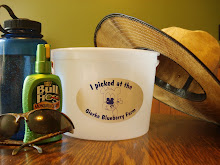First Real Berry Report for 2007: Opening Day Looks like 1 August

Please bear with us as we continue to learn about the management side of commercial blueberry farming. The two most common questions we encounter are: "How do the berries look?" and "When can we start picking?" The answers require us to develop some experience with this to be able to answer them specifically.
The berry crop looks better than last year, which was a poor year (less than 3000 lbs picked), but not as good as 2005, which was a banner year (more than 10,000 lbs harvested). So those of you with a memory capacity of 2 yrs or better, don't get your hopes up about 2005-like conditions but then don't fret that it will be as bad as last year, depending on when you come. As for "when," the berries are at LEAST 2, maybe 3, weeks from being ripe enough to start picking. We will announce the opening on our answering machine, this blog, and some classified ads in the paper. The pictures included here show a couple of varieties that photographed on July 6th.

Other common questions pertain to why do the berry yields vary so much? There is information at this link (also titled, "Blueberry Information on the right sidebar of this blog) that discusses some of the issues, which are multifaceted: winter conditions, moisture, pollination. Since we have different varieties (near as we can tell, about 4 or so) that blossom at slightly different times (over a period of a couple of weeks in early June (typically for us)), the weather conditions can negatively affect one variety while another experiences better conditions at a more optimum time. We see evidence of this in that some bushes are almost devoid of berries while others are loaded. This probably means that the bushes lacking berries blossomed at poor pollinating conditions. We tried to help the pollination by having some bees placed on the fields, but the beekeeper we were working with fell victim to poor beekeeping conditions and was not able to help this year. There were still a lot of natural pollinators around (the pictures below of some examples, although we see mostly swallowtail butterflies, bumblebees, and, to a lesser extent, honeybees (maybe because they are harder to see) were taken by Gen a few weeks ago down in Lansing) during the blossom season, but their presence does not necessarily guarantee pollination because they can be doing all that work for naught if the conditions are poor for the nectar/pollen. There really is no way to measure the effectiveness and so we are at the mercy of nature. We do not have the capacity to irrigate, so we are also subject to the vagaries of precipitation. We continue to mow the grass, which not only makes it easier to pick, but enhances air flow and keeps down weeds and diseases. Pruning, too, but we have not caught up to the neglect of decades ago.





0 Comments:
Post a Comment
<< Home